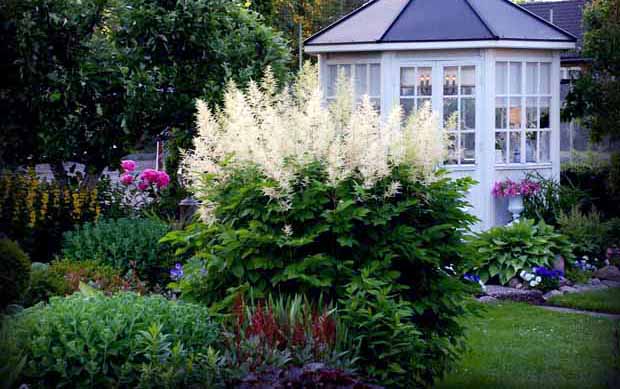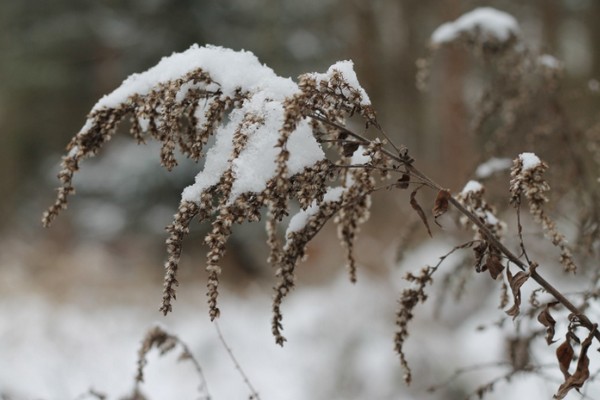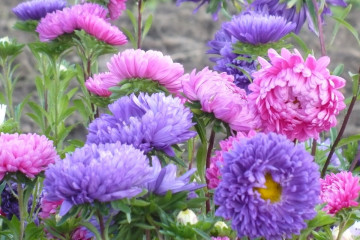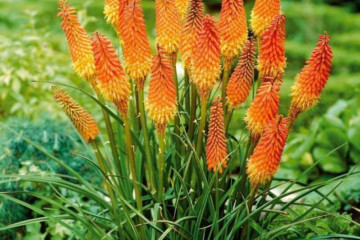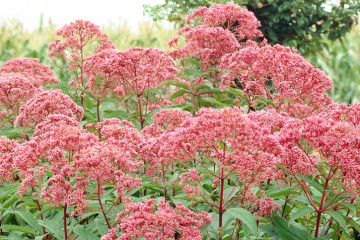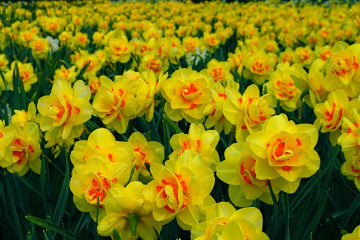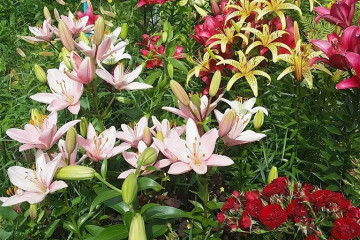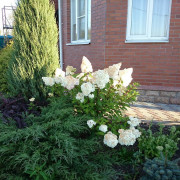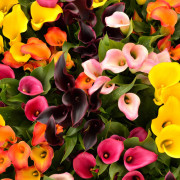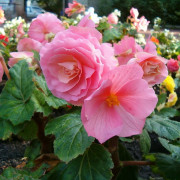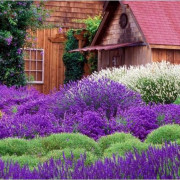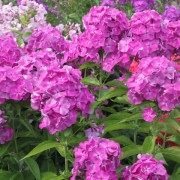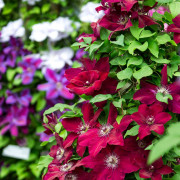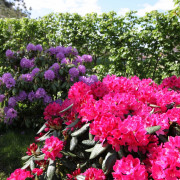Astilba - planting and care in the open field
Content:
The herbaceous perennial astilba belongs to the saxifrage family. Its name, derived from the combination of the Latin words "a", meaning without, and "stilba", translated as shine, the plant owes to the Scottish florist Lord Hamilton. The original habitats are North America and eastern Eurasia. It grows in forests of deciduous trees, near streams and in areas with high summer humidity.
Astilba - planting and care in the open field
The impressive variety of the saxifrage family includes hardy and undemanding plants for the most part. Astilba needs to follow a few simple rules when planting and caring for it. The correct time and place of planting are the guarantee of healthy growth and splendor of inflorescences.
How to properly plant a purchased astilba in the garden
The best time to buy planting material is the first days of its availability on sale. Due to the belonging of this flower to rhizome plants, there is a risk of pulling out the shoots during storage in the store. Also, shoots can dry out, rot in wet soil and be damaged during transportation, which often serves as the reason why astilbe does not bloom.
The main nuance is the preservation of the rhizome. A plant that has released shoots will take root, however, it will be weakened and in the first year it may have an unhealthy appearance. The purchase should be stored in the refrigerator until disembarking, the flower can withstand frosts down to -37 ° C.
What you may need when landing
When planting, you will need mulch and organic fertilizers. This is the best way to feed Astilba. In the natural habitat of this flower, both wooded and swampy soils are located, while he most of all loves places near water bodies. The best option would be loose, humus-rich soil.
Where is it better to plant astilba
This shrub does not tolerate direct sunlight, so shady areas of the garden are preferred. Ideal would be a combination of shade with a high-flowing underground current.
The soil must be moist or often damp; most astilba species will not survive drought. A pH of 5.5–6.5 is a good acidity level. Drying out of the soil is one of the common reasons why Astilba leaves curl and dry. A positive factor will be the proximity of a fountain or pool. It is recommended to clear weeds and dig up the area before planting the flower.
Stages of the planting process
First, a deepening is made for the length of the rhizome of such a width that it fits freely there. If the seedling is in a pot, it must be pre-watered, and it should also be planted at a depth identical to its position.
The sprouts are planted at least 30 cm from each other, with a high grade the recommended distance reaches 50 cm.Organic fertilizers and hydrogel are introduced into the hole if necessary, after which it is covered with soil compacted at the roots, forming a circular lowland.
The flower is watered abundantly, while roots should not appear from the settled soil. The surroundings of the top with sprouts are generously sprinkled with mulch. Compost, sawdust, or bark are good options. In a dry climate, during the adaptation period of the plant, watering is performed every other day.
A high agricultural background in combination with a sufficient level of moisture and nutrients in the soil will provide the shrub with decades of existence. Moderate nitrogen fertilization is recommended to stimulate foliage renewal in early spring.
Planting can also be done in soil pre-fertilized with organic matter (2 buckets / m2), in this case, the hole is fertilized with a large spoonful of mineral dressing and half a glass of ash.
How a flower multiplies
Reproduction of astilba is carried out by means of seeds, cuttings and dividing the bushes.
Cuttings
During the spring growing season, buds that have released new shoots are cut off with a sharp blade. Ash is applied to the cut. New shoots are planted in moist soil with a high content of crushed gravel or coarse sand, where a greenhouse effect is created. Greenhouse conditions are also suitable.
Germinating seeds
There are differing opinions on the benefits of seed growing. Its supporters argue that this is the only way to get new varieties. Opponents claim that only high-quality selection seeds are suitable to preserve varietal qualities, otherwise the culture may turn out to be distorted.
As arguments, they cite the risks of such deviations:
- color changes;
- intermittent inflorescences and irregular panicle shapes;
- reduced decorativeness;
- change in flowering period.
The seed is placed on moist soil, where greenhouse conditions are provided for it. High humidity accelerates growth, the main threat to young plants is water shortage. They need good lighting, but they need to be protected from direct planting rays.
Dividing the astilba bush
This method of propagating the bush is popular for its high degree of reliability. The main plant is carefully dug out in early spring, its delicate rhizome is cut into sections with 3-2 buds. The sections are processed with ash, then the usual planting is performed.
It is recommended to supplement the applied fertilizers with stimulants of the growth of the root system. The plantings are regularly loosened and watered, new astilbe can bloom in September.
Astilba care
In addition to timely watering, dressing and loosening of the soil, it is necessary to take into account the gradual dying off of the lower rhizome and the growth of the upper one, which requires observation and hilling. The answer to the question of why astilbe grows poorly is often the influence of the environment on the exposed rhizome, which is vulnerable to it.
How to water a flower
Astilba, the care of which primarily implies sufficient watering, gains from 15 to 200 cm in height. She decorates shaded areas of the cottage and garden with her broomsticks growing from 10 to 60 cm.
The amount of watering depends on the variety, mainly medium to high amounts of water. It should be sufficient to maintain soil moisture; the soil should not be allowed to dry out. This is usually 2-3 times a week. In the heat, the bush is watered at least once a day; watering in the morning and evening would be a good option.
Fertilization
The time for top dressing comes several times a year:
- Nitrogen fertilizers in early spring. They can be applied in a mixture with soil for hilling.
- Potassium nitrate in an amount of half a liter per bush from 1 tbsp. l. 5 liters of water before the beginning of summer flowering.
- 1 tbsp. l. dry superphosphate on the bush at the end.
- In the fall, phosphorus and potassium are introduced in 1-2 tbsp. l. fertilizer diluted with water on a bush, they will completely dissolve only by spring.
Pre-watering is mandatory, although it can be replaced by rain. The soil should subsequently be loosened and covered with mulch.
Features of care during flowering
Astilba flowers are colored red, purple, white and pink. In the motley genus of this saxifrage, there are varieties that differ in pyramidal, drooping and rhombic inflorescences. A graceful bush is formed from massive dark green leaves planted on long petioles, which blooms from early to late summer.
In this season, the need for flowering astilba in water increases. Faded stems of flowers are cut at will, they retain the effect of ennobling the garden and being semi-dry. Spreading as it grows, the shrub itself displaces weeds, but the soil still needs loosening and mulch.
It is not recommended to allow the flowering of plants less than a year old; it is better to prune their peduncles even before the formation of panicles. So the roots of young seedlings will get stronger, and it will be easier for them to survive the winter.
Features of care during the rest period
In addition to top dressing in early autumn, another important step is pruning the ground section of the bush. It is performed with a pruner, which is disinfected in a pink solution of potassium sour manganese for half an hour after each flower in order to prevent possible infection. It can be introduced during flowering, or it can be caused by a fungus that appears as a result of stagnant water in the soil. It is also one of the reasons for poor growth, drying, deformation and yellowing of leaves.
If there is no need for seeds, it is better to cut the flower stalks before their formation, since this will take the plant's strength. The time to delete the rest depends on the region, the deadline is late November. This plant is of the rhizome type; upon the onset of autumn frosts, the ground part of the flower dies off, growing back in spring. When the first frosts come, the bush will begin to dry out and darken. This indicates the time to cut dry stems and shoots.
Preparing for winter
Pruning is done for more reliable mulching for the winter, the layer thickness of which should be from 5 to 10 cm. In winter, you do not need to take care of the flower.If the ground part is retained in whole or in part, the plant will be less protected.
Despite its resistance to frost, in cold weather with a small amount of snow, the shrub can freeze out. Rhizomes older than 5 years will already slightly protrude from the ground, for their shelter for the winter, it is necessary to build a small fence of boards or stones in the garden, fill the inner space with dry leaves, and stretch a non-woven fabric on top, for fidelity fixed with stones at the edges.
Astilba: planting and care in the open field in the Urals
Due to the Ural climatic features, planting, transplanting and spring sowing of astilbe is best done at the end of May. Some gardeners of the Urals in the autumn, in addition to simple pruning and mulching of rhizomes, prefer to equip a fence with dry leaves and a non-woven coating fixed at the edges, regardless of the age of the plant. This serves as a more reliable protection from the Ural weather. Otherwise, planting and caring for astilba do not differ from botanical recommendations both for the Moscow region and for the regions located to the south.
Astilba: planting and care outdoors in Siberia
An outstanding feature of this perennial shrub is that the growing season will not be stable at temperatures below 10 ° C. Due to the harsh weather conditions of Siberia in comparison with the western climate, astilbe can only wake up in late spring or early summer. At this time, transplanting, planting and sowing are performed here.
In Siberia, as early as autumn, mulching begins, using sawdust and crushed tree bark as a material. The flower propagates mainly by dividing the bush. Watering, feeding, pruning and covering are carried out identically to other regions.
Astilba saxifrage, which beautifies nature, when taken care of in the garden, gives it a luxurious and impressive appearance. The plant does not like a lot of sunlight and requires an abundant amount of water, but it is unassuming to care for, and the compositions created from it can compete with architectural ensembles. Due to the peculiarities of its vital activity, astilbe grows in the East, Asia, Europe, North America and even in the Far North.



